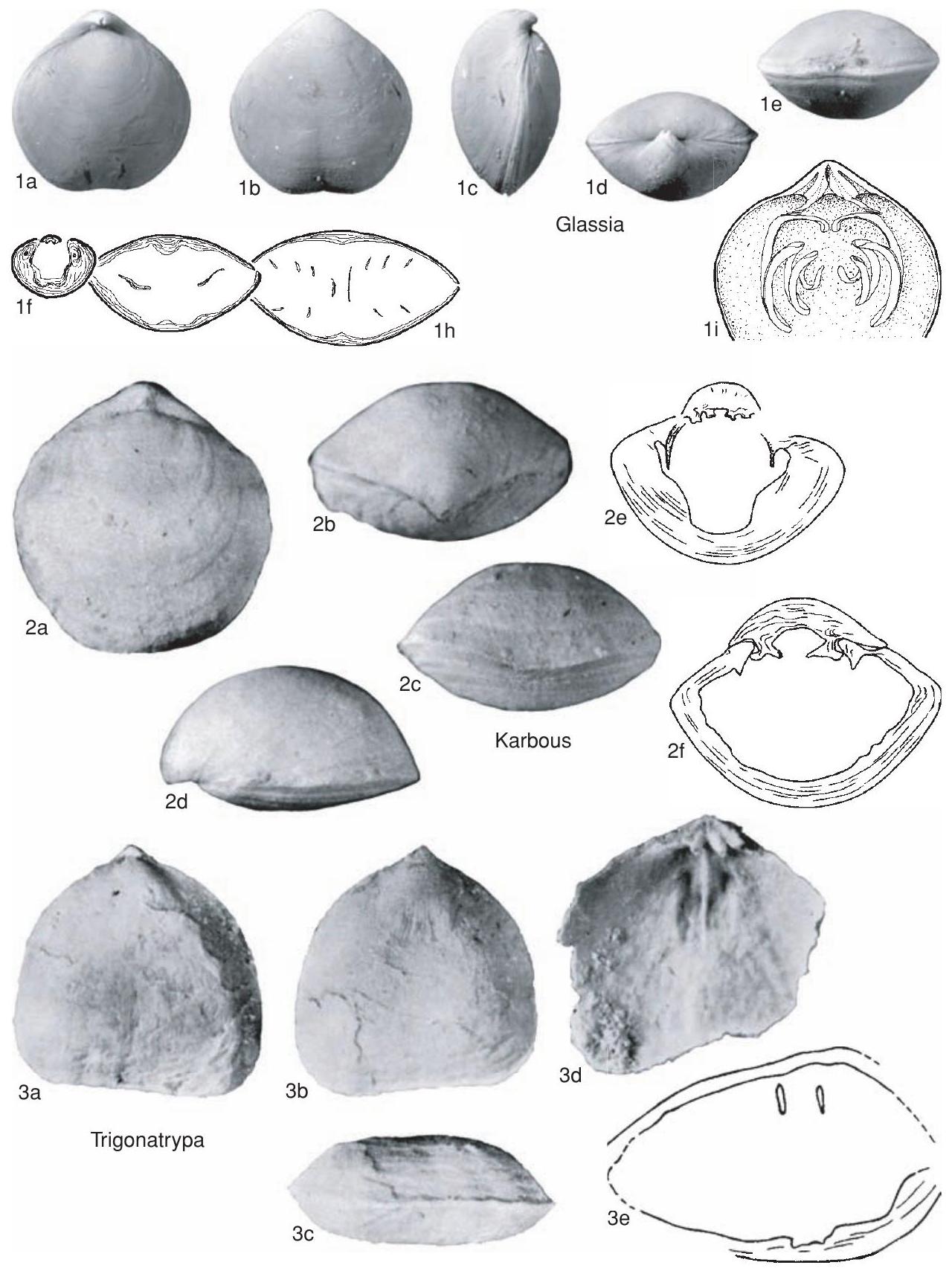Welcome to the Treatise on Invertebrate Paleontology!
Please enter a genera name to retrieve more information.

Glassia
Classification
Phylum:
Brachiopoda
Subphylum:
Rhynchonelliformea
Class:
Rhynchonellata
Order:
Atrypida
Suborder:
Lissatrypoidina
Superfamily:
Glassioidea
Family:
Glassiidae
Formal Genus Name and Reference:
Glassia DAVIDSON, 1881a, p. 11
Type Species:
Glassia elongata DAVIDSON, 1881b, p. 148, OD
Images
(Click to enlarge in a new window)
Fig. 997, 1a-e. *G. sp. cf. G. elongata (Davidson), Wenlock, Gotland, dorsal, ventral, lateral, posterior, anterior views, × 3 (new), Fig. 997, 1f-i. *G. elongata (Davidson), Wenlock, United Kingdom, f-h, serial sections, × 5, i, reconstruction of brachidium, × 5 (new)
Synonyms
Cryptatrypa
Geographic Distribution
western Europe, Urals, ?northern Canada
Age Range
Beginning Stage in Treatise Usage:
Silurian (?upper Llandovery, Wenlock)
Beginning International Stage:
Telychian
Fraction Up In Beginning Stage:
0
Beginning Date:
438.59
Ending Stage in Treatise Usage:
Silurian (Ludlow, ?Přídolí)
Ending International Stage:
Pridoli
Fraction Up In Ending Stage:
100
Ending Date:
419
Description
Small, biconvex to weakly ventribiconvex, rounded to elongate; small anacline-hypercline area; beak obscuring minute apical-transapical foramen; deltidial plates minute or absent; commissure ligate (both valves sulcate) to rectimarginate, thick shell wall, medium septum common in both valves, teeth distally solid or with minute apical dental cavities, buried dental plates, thick, squared hinge plate divided by narrow cardinal pit, spiralia barrel shaped, medially directed, fewer than 6 whorls, ventroposterior jugal processes terminating in hooks. [The originally and unfortunately designated type species of Glassia, G. obovata (SOWERBY), is a species of Lissatrypa (family Lissatrypidae), with dorsally directed spiralia; DAVIDSON (1881b) correctly identified Glassia elongata with medially directed spiralia, typical of the family Glassiidae as defined by SCHUCHERT and LEVENE (1929a) and used by DAVIDSON in his diagnosis of the genus. This species was then selected as type (COPPER , 1996b).]
References
Museum or Author Information
Classification
Phylum:
Brachiopoda
Subphylum:
Rhynchonelliformea
Class:
Rhynchonellata
Order:
Atrypida
Suborder:
Lissatrypoidina
Superfamily:
Glassioidea
Family:
Glassiidae
Formal Genus Name and Reference:
Glassia DAVIDSON, 1881a, p. 11
Type Species:
Glassia elongata DAVIDSON, 1881b, p. 148, OD
Images
(Click to enlarge in a new window)
Fig. 997, 1a-e. *G. sp. cf. G. elongata (Davidson), Wenlock, Gotland, dorsal, ventral, lateral, posterior, anterior views, × 3 (new), Fig. 997, 1f-i. *G. elongata (Davidson), Wenlock, United Kingdom, f-h, serial sections, × 5, i, reconstruction of brachidium, × 5 (new)
Synonyms
Cryptatrypa
Geographic Distribution
western Europe, Urals, ?northern Canada
Age Range
Beginning Stage in Treatise Usage:
Silurian (?upper Llandovery, Wenlock)
Beginning International Stage:
Telychian
Fraction Up In Beginning Stage:
0
Beginning Date:
438.59
Ending Stage in Treatise Usage:
Silurian (Ludlow, ?Přídolí)
Ending International Stage:
Pridoli
Fraction Up In Ending Stage:
100
Ending Date:
419
Description
Small, biconvex to weakly ventribiconvex, rounded to elongate; small anacline-hypercline area; beak obscuring minute apical-transapical foramen; deltidial plates minute or absent; commissure ligate (both valves sulcate) to rectimarginate, thick shell wall, medium septum common in both valves, teeth distally solid or with minute apical dental cavities, buried dental plates, thick, squared hinge plate divided by narrow cardinal pit, spiralia barrel shaped, medially directed, fewer than 6 whorls, ventroposterior jugal processes terminating in hooks. [The originally and unfortunately designated type species of Glassia, G. obovata (SOWERBY), is a species of Lissatrypa (family Lissatrypidae), with dorsally directed spiralia; DAVIDSON (1881b) correctly identified Glassia elongata with medially directed spiralia, typical of the family Glassiidae as defined by SCHUCHERT and LEVENE (1929a) and used by DAVIDSON in his diagnosis of the genus. This species was then selected as type (COPPER , 1996b).]
